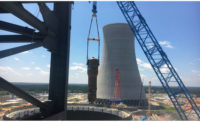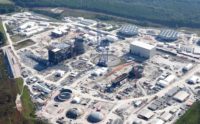Far Over Budget and Extremely Late
Plan to Accelerate Georgia Nuclear Power Project Failed Badly
With the cost still rising, project observers say Plant Vogtle still lacks an adequate schedule

A new contracting team and its revised approach to the Plant Vogtle nuclear expansion in Georgia failed by a wide measure to accelerate construction, according to testimony filed June 8 by Public Service Commission staff and an independent construction monitor.
Contractors also continued their long-standing practice of working without a “fully integrated and resource-loaded” integrated project schedule (IPS), a factor cited in the testimony as a possible contributing factor for the turmoil now roiling Westinghouse and its parent company, Toshiba Corp. The testimony marks the first from PSC staff and construction monitors since Westinghouse Electric Co. filed for bankruptcy protection in March.
Despite Westinghouse and its main subcontractor, Fluor, publicly celebrating their takeover of the project in early 2016, construction fell considerably further behind schedule during the year, a trend that continues today, say monitors.
Despite Westinghouse and its main subcontractor, Fluor, publicly celebrating their takeover of the project in early 2016, construction fell considerably further behind schedule during the year, a trend that continues today, say monitors. For the one-year period of April 2016-April 2017, for instance, four critical path construction activities experienced an average of 325 days of schedule delay. One milestone, completing construction of an Annex building, saw 396 days added to its target completion date during that 365-day period.
The testimony specifies some of the setbacks for Plant Vogtle, one of two new nuclear power plant projects undertaken eight years ago with a new reactor design, government incentives and hope for a rebirth of nuclear power plant construction in the U.S. The other project, V.C. Summer in South Carolina, where Westinghouse also is the prime contractor, is similarly far over budget and behind schedule. Within months, both Georgia Power, South Carolina Electric & Gas and their respective state public service commissions must decide whether to abandon the projects or keep building.
At Plant Vogtle, Fluor intended its “Step Change Initiative”—enacted shortly after Westinghouse hired the firm to lead general construction activities—to notably accelerate construction productivity on site.
In early 2016, Fluor senior vice president and Vogtle site director Darrell Waters told ENR of the effort: “It’s the owners’ and Westinghouse’s desire to see a step-change in performance here very quickly. We are confident that we can change this project.” Waters, a veteran of the Tappan Zee Bridge project whom Fluor tapped to lead the Vogtle job—who now works for Walsh Construction—wasn’t the only project executive raising expectations at the time.
Also in early 2016, Jeff Benjamin, then senior vice president with Westinghouse, told ENR: “We know how important these projects are … and we will do what we need to do to be successful.”
Their plan sought to forge a performance improvement within 90 days of Jan. 1, 2016, with the goal of completing 2.3 percent of the project per month by the end of the year, and as much as 3 percent per month by mid-2017. The plan fell far short.
From July through the end of December, Roetger and Jacobs testified that total project completion instead averaged 0.7 percent per month.
“The Step Change Initiative, while improving some functional areas, failed to achieve improvement in production and productivity,” Steven Roetger, the PSC staff’s lead analyst, and William Jacobs, the state’s independent construction monitor, stated in joint testimony. While Fluor implemented some improvements, they had “no significant impact on construction percent complete per month or on productivity.”
At the same time, contractors continued to work without a fully integrated project schedule. Georgia PSC staff has been advising of the need for a “reasonable, fully integrated and resource-loaded IPS” for roughly five years, the testimony indicated. The impact of the project progressing without such a schedule proved significant to its current status, the men stated.
“If the Parties to the EPC Agreement had developed a reasonable, integrated, and resource loaded IPS and ETC, this current expansion of costs to complete the Project would have been known, or should have been known, years ago,” the two men stated. In turn, knowing those costs earlier would have influenced analysis of the project’s economic merits.
More pointedly, Roetger and Jacobs added: “Westinghouse’s voluntary bankruptcy was not the result of unforeseen or uncontrollable circumstances.... Stone and Webster, regardless of its parent company, was incurring billions of dollars in losses related to the Project. There was no reason to believe that these losses would simply stop because of Westinghouse’s purchase of Stone and Webster.”
For its latest testimony, PSC staff focused on four Unit 3 milestones on the project’s critical path, all of which endured big delays between April 2016 and April 2017. These milestones and their respective schedule delays included: achieve Unit 3 Containment building elevation of 107 ft.—delayed by 272 days; achieving Unit 3 Shield Building elevation 149 ft—293 days; achieve Unit 3 Auxiliary Building to elevation 100 ft—340 days; and completing construction for Annex Areas 1-3—396 days.
Beyond specifying schedule slippage, Roetger and Jacobs report that the contractors, perhaps viewing craft productivity as a problem area, sought to figure out exactly how the project’s work force was spending its time. To that end, the contractor hired a consultant to conduct a five-week field study, from August to October 2016.
The study measured, for example, what percent of an average worker’s time was spent on direct work activities, activities that were “work-related,” and other categories, such as “non-work related.” While the specific percentages for each of these were redacted from the publicly available testimony, Roetger and Jacobs noted that a follow-up visit by the consultant in early 2017 “showed some improvement but indicated that idle time, early quits and late starts remained high.”
Georgia Power Seeks Project Takeover
A day after that testimony was submitted, on June 9, Georgia Power announced it had entered into a new agreement with Westinghouse’s parent company, Toshiba, aimed at transferring project management to the utility. Also, the utility states that the agreement “affirms the value of Toshiba’s guarantee at $3.68 billion.”
“We are pleased with today’s positive developments with Toshiba and Westinghouse that allow momentum to continue at the site while we transition project management from Westinghouse to Southern Nuclear and Georgia Power,” Paul Bowers, chairman, president and CEO of Georgia Power, said via the June 9 statement.
The utility is continuing to work on completing a full-scale schedule and cost-to-complete analysis, Bowers added. “We are happy to have Toshiba’s cooperation in connection with this agreement which provides a strong foundation for the future of these nuclear power plants,” said Thomas A. Fanning, chairman, president and CEO of Southern Company.
The agreement—already approved by the U.S. Dept. of Energy—will take effect after approval of the bankruptcy court and rejection of the current engineering, procurement and construction contract by Westinghouse. An interim agreement between Georgia Power and Westinghouse allowing construction work to continue has been extended through June 22.
Neither Georgia Power nor the Georgia PSC has made a final decision on how to proceed. Nevertheless, some PSC commissioners have publicly voiced a preference for forging ahead, despite the disastrous results to date.
For example, in an email sent in late May to several parties, including ENR, PSC Commissioner Tim Echols said, “At this point, if we can finish these units I prefer to do that. We have come too far.”





